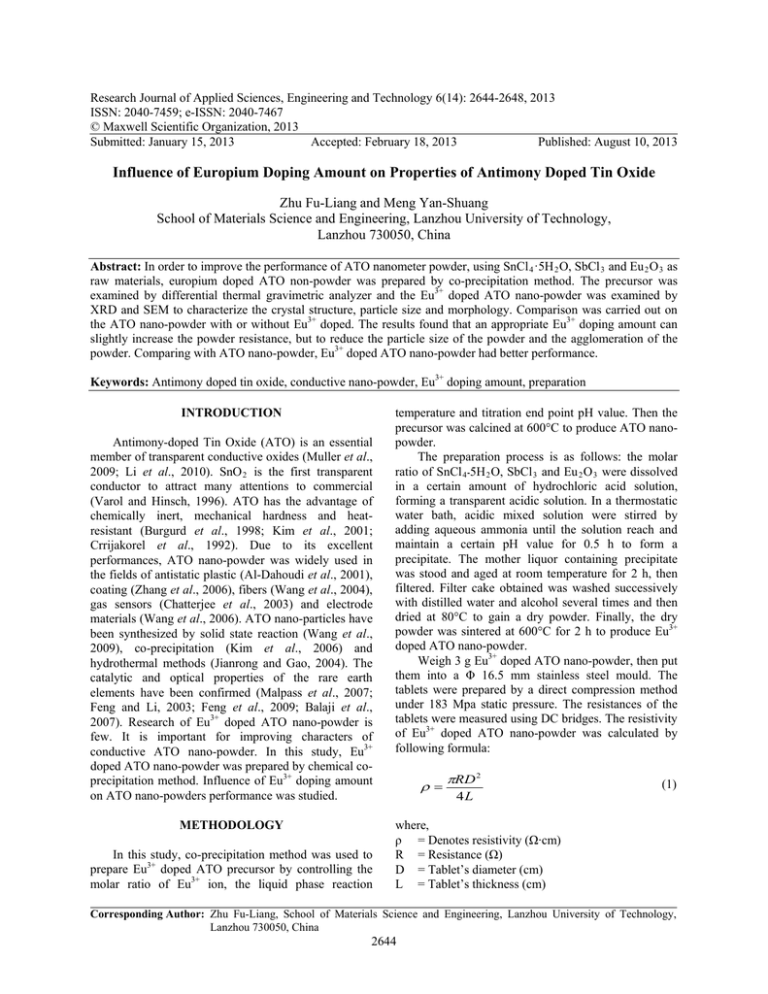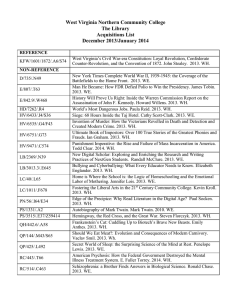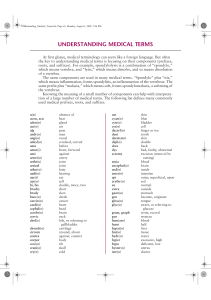Research Journal of Applied Sciences, Engineering and Technology 6(14): 2644-2648,... ISSN: 2040-7459; e-ISSN: 2040-7467
advertisement

Research Journal of Applied Sciences, Engineering and Technology 6(14): 2644-2648, 2013 ISSN: 2040-7459; e-ISSN: 2040-7467 © Maxwell Scientific Organization, 2013 Submitted: January 15, 2013 Accepted: February 18, 2013 Published: August 10, 2013 Influence of Europium Doping Amount on Properties of Antimony Doped Tin Oxide Zhu Fu-Liang and Meng Yan-Shuang School of Materials Science and Engineering, Lanzhou University of Technology, Lanzhou 730050, China Abstract: In order to improve the performance of ATO nanometer powder, using SnCl 4 ·5H 2 O, SbCl 3 and Eu 2 O 3 as raw materials, europium doped ATO non-powder was prepared by co-precipitation method. The precursor was examined by differential thermal gravimetric analyzer and the Eu3+ doped ATO nano-powder was examined by XRD and SEM to characterize the crystal structure, particle size and morphology. Comparison was carried out on the ATO nano-powder with or without Eu3+ doped. The results found that an appropriate Eu3+ doping amount can slightly increase the powder resistance, but to reduce the particle size of the powder and the agglomeration of the powder. Comparing with ATO nano-powder, Eu3+ doped ATO nano-powder had better performance. Keywords: Antimony doped tin oxide, conductive nano-powder, Eu3+ doping amount, preparation INTRODUCTION Antimony-doped Tin Oxide (ATO) is an essential member of transparent conductive oxides (Muller et al., 2009; Li et al., 2010). SnO 2 is the first transparent conductor to attract many attentions to commercial (Varol and Hinsch, 1996). ATO has the advantage of chemically inert, mechanical hardness and heatresistant (Burgurd et al., 1998; Kim et al., 2001; Crrijakorel et al., 1992). Due to its excellent performances, ATO nano-powder was widely used in the fields of antistatic plastic (Al-Dahoudi et al., 2001), coating (Zhang et al., 2006), fibers (Wang et al., 2004), gas sensors (Chatterjee et al., 2003) and electrode materials (Wang et al., 2006). ATO nano-particles have been synthesized by solid state reaction (Wang et al., 2009), co-precipitation (Kim et al., 2006) and hydrothermal methods (Jianrong and Gao, 2004). The catalytic and optical properties of the rare earth elements have been confirmed (Malpass et al., 2007; Feng and Li, 2003; Feng et al., 2009; Balaji et al., 2007). Research of Eu3+ doped ATO nano-powder is few. It is important for improving characters of conductive ATO nano-powder. In this study, Eu3+ doped ATO nano-powder was prepared by chemical coprecipitation method. Influence of Eu3+ doping amount on ATO nano-powders performance was studied. METHODOLOGY In this study, co-precipitation method was used to prepare Eu3+ doped ATO precursor by controlling the molar ratio of Eu3+ ion, the liquid phase reaction temperature and titration end point pH value. Then the precursor was calcined at 600°C to produce ATO nanopowder. The preparation process is as follows: the molar ratio of SnCl 4 ۔5H 2 O, SbCl 3 and Eu 2 O 3 were dissolved in a certain amount of hydrochloric acid solution, forming a transparent acidic solution. In a thermostatic water bath, acidic mixed solution were stirred by adding aqueous ammonia until the solution reach and maintain a certain pH value for 0.5 h to form a precipitate. The mother liquor containing precipitate was stood and aged at room temperature for 2 h, then filtered. Filter cake obtained was washed successively with distilled water and alcohol several times and then dried at 80°C to gain a dry powder. Finally, the dry powder was sintered at 600°C for 2 h to produce Eu3+ doped ATO nano-powder. Weigh 3 g Eu3+ doped ATO nano-powder, then put them into a Φ 16.5 mm stainless steel mould. The tablets were prepared by a direct compression method under 183 Mpa static pressure. The resistances of the tablets were measured using DC bridges. The resistivity of Eu3+ doped ATO nano-powder was calculated by following formula: ρ= πRD 2 (1) 4L where, ρ = Denotes resistivity (Ω∙cm) R = Resistance (Ω) D = Tablet’s diameter (cm) L = Tablet’s thickness (cm) Corresponding Author: Zhu Fu-Liang, School of Materials Science and Engineering, Lanzhou University of Technology, Lanzhou 730050, China 2644 Res. J. Appl. Sci. Eng. Technol., 6(14): 2644-2648, 2013 RESULTS AND DISCUSSION Effect of Eu3+ doping amount on ATO resistivity: Figure 2 shows the relationship of ATO resistivity with different molar ratio of Eu3+ ion under the conditions of pH = 9, the reaction temperature = 60°C and heat treatment temperature = 600°C. It indicated that the ATO resistivity increased significantly with the increase of molar ratio of Eu3+ ion. SnO 2 is a wide band gap n-type semiconductor, whose resistivity is larger. Research (Jeon et al., 2005) found that the composition of the SnO 2 powder particles was deviated from the stoichiometric ratio of SnO 2 . Doping with other elements can be taken to improve the conductive properties of the SnO 2 powder. After heat treatment, Sb5+ and Eu3+ ions doped dissolved in the SnO 2 lattice, Sb5+ and Eu3+ ions easily became substitutional ions to occupy Sn4+ position. When Sb5+ ion occupied Sn4+ position in the SnO 2 lattice, a positively charged ion and an excess of valence electron were formed. The valence electron easily broke free of the shackles to be a conduction electron. Therefore, Sb5+ ion doped into SnO 2 can increase net conduction electron and increase the ATO conductivity. Rare earth europium represented +3 valence and Eu3+ ion was acceptor level for SnO 2 . So presence of Eu3+ ion will increase the resistivity of the ATO powder. When Eu3+ doping amount was lower, the increase of ATO nano-powder resistivity was relatively small. Nontheless, continuing to increase the molar ratio of Eu3+ ion, the resistivity of the ATO nanopowder will increase rapidly. The ionic radius of Sn4+ is 0.071 nm and the ionic radius of Eu3+ (0.095 nm) is much larger than that of Sn4+. When Eu3+ ion substitute Sn4+ ion in the SnO 2 lattice, SnO 2 lattice will be deformed and movement of conductive carrier will be hindered, reducing ATO nano-powder conductivity. When Eu3+ doping amount was very low, distortion of SnO 2 lattice was also insignificant and had no apparent effect on ATO resistivity. Distortion rate of SnO 2 lattice was increased with the increase of the molar ratio of Eu3+ ion, resulting in an increase of ATO resistivity. According to the effect of Eu3+ doping amount on ATO nanopowder resistivity, molar ratio of Eu3+ ion was selected as 1%. Thermogravimetric analysis of the precursor: Thermal decomposition result of the precursor under optimum conditions from the ambient temperature to 800°C in nitrogen atmosphere was given in Fig. 1. The DSC/TG curves indicate that a little, endothermic effect, one DSC peak is observed about 90°C, which can be considered to the evolution of water in the precursor. The two endothermic peaks with 22% weight loss at about 220 and 320°C are observed for the decomposition of Sn (OH) 4 and Sb (OH) 3 with reactions Sn (OH) 4 = SnO 2 + 2H 2 O and 2Sb (OH) 3 = Sb 2 O 3 + 3H 2 O, respectively. XRD and average grain size of ATO nano-powder with different molar ratio of Eu3+ion: XRD patterns of ATO nano-powder after heat treatment for 2 h with different molar ratio of Eu3+ ion were given in Fig. 3. As can be seen from Fig. 3, incorporation of Eu3+ does not form a phase containing europium and the crystal structure of the ATO nano-powder remains tetragonal rutile structure of SnO 2 . Nevertheless, incorporation of Eu3+ influences the orientation of the crystal and the average grain size. Diffraction peak intensity of ATO nano-powder becomes weaker and weaker with the increase of the molar ratio of Eu3+ and peak width is Fig. 1: DSC/TG curves of precursor Fig. 2: Resistivity of ATO nano-powder with different molar ratio of Eu3+ ion The thermal decomposition behavior of the precursor obtained was investigated by DSC/TG (TA, SDT-2960 and USA). XRD analysis of the Eu3+ doped ATO nano-powder was performed on a XRD diffractometry (Rigaku, D/max-rA10, Japan). Morphology of Eu3+ doped ATO nano-powder was characterized on a Scanning Electron Microscope (SEM) (JEOL, JSM 5600LV, Japan). 2645 Res. J. Appl. Sci. Eng. Technol., 6(14): 2644-2648, 2013 Fig. 3: XRD patterns of ATO nano-powder with different molar ratio of Eu3+ ion increasing, indicating that crystallinity of the ATO powder becomes poor and the grain size becomes small. Grain size of ATO nano-powder can be approximately estimated by Scherrer formula. The calculation of average grain size of ATO powder with different molar ratio of Eu3+ ion was given in Fig. 4. It is obvious that the grain size of ATO powder is smaller when Eu3+ doped in ATO powder. When the molar ratio rapidly. Doped Eu3+ ion has replaced Sn4+ into the SnO 2 of Eu3+ ion exceeds 1%, ATO powder grain size decreases lattice to form a solid solution. A large Fig. 4: Average grain size of ATO powder with different molar ratio of Eu3+ ion number of lattice defects will be produced in the substitution process. It makes lower crystallinity degree of ATO powder and the lattice structure of SnO 2 is not complete. Simultaneously, the Eu3+ concentration in the crystal surface is relatively high, increasing the surface diffusion barrier. So that the grain boundary diffusion activation energy increases, hindering the diffusion movement of the grain boundary. Less Eu3+ doping amount has a small effect on SnO 2 lattice and surface diffusion barrier and the grain size of ATO powder changes little. With the increase of molar ratio Fig. 5: SEM images of ATO powder with different molar ratio of Eu3+ ion (a) 0%, (b) 1%, (c) 5% 2646 Res. J. Appl. Sci. Eng. Technol., 6(14): 2644-2648, 2013 Table 1: Ti/SnO 2 -Sb electrode electro-catalytic efficiency and electrode life Molar ratio of Eu3+ ion/% 0% Electro-catalytic degradation efficiency of 48.3% electrode/ % Electrode life/hour 26.1 degradation 1% 69.1% CONCLUSION • 56.6 of Eu3+ ion,its impact on SnO 2 lattice and surface diffusion barrier will continue to increase, thus impeding the growth rate of the ATO powder grains and decreasing the grain size of the ATO powder. Considering the effect of Eu3+ doping amount on conductive properties, structure and grain size of ATO powder, molar ratio of 1% Eu3+ ion is more appropriate. Morphology analysis of ATO nano-powder: Figure 5a, b and c are SEM pictures of ATO nanopowder with the molar ratio of 0, 1 and 5% Eu+ ion, respectively. As can be seen from Fig. 5, there are different degrees of agglomeration for three molar ratios of ATO powder. Agglomerations of un-doped (Fig. 5a) and 1% Eu3+ ion doped powder (Fig. 5b) are more serious, but 1% Eu3+ doped powder is smaller than that of un-doped powder. Comparing with the undoped and 1% Eu3+ doped ATO powder, agglomeration for molar ratio of 5% Eu3+ doped ATO powder is significantly smaller and single irregular ellipsoidal ATO powder particles can be seen from Fig. 5c. Different agglomeration of the above mentioned three molar ratios of Eu3+ doped ATO powder indicates that ATO powder doped with Eu3+can reduce the powder agglomeration. Nano-powder prone to soft reunion due to its small particle has a great specific surface and the surface atoms of powder are extremely active for the presence of a large number of vacancy bonds, which make the van der Waals force, are very large. The presence of van der Waals force is easy to cause the powder agglomeration. Research (Qiang et al., 1999) found that the powder surface existed potential, which was closed related to powder dispersion. Enrichment of Eu3+ ion in the powder surface is able to increase the surface potential of the powder and repulsive effects between the same kinds of particles. Thereby the action of the van der Waals force is offset and agglomeration of the powder is reduced. Electro-catalytic degradation performance of Eu3+ doped Ti/SnO 2 -Sb electrode prepared by ATO nano-powder: Using p-nitrophenol as a target organic, electro-catalytic degradation performances and life of Eu3+ doped Ti/SnO 2 -Sb electrode prepared by the molar ratio of 0% and 1% Eu3+ doped ATO nano-powder was carried out, respectively. The results were listed in Table 1. Eu3+ doped has an observable effect on electrocatalytic degradation performance and electrode life of Ti/SnO 2 -Sb electrode. Therefore, an appropriate Eu3+ doped in ATO nano-powder can apparently increase powder electro-catalytic performance. • Eu3+ doped ATO nano-powder was prepared by coprecipitation method. The effect of Eu3+ doping amount on properties of ATO nano-powder was investigated. The results found that the molar ratio of 1% Eu3+ doping amount can significantly improve the electro-catalytic performance of the ATO nano-powder. Electro-catalytic degradation efficiency of 1% Eu3+ doped electrode, which is greater than that of Eu3+ un-doped electrode, is up to 69.1%. Eu3+ doped in ATO nano-powder can reduce the grain size and agglomeration of powder, but will increase the resistivity of the powder. Eu3+ doped in ATO powder does not change the rutile structure of SnO 2 . ACKNOWLEDGMENT The project was supported by the Natural Science Foundation of Gansu Province under grand No. 3ZSO42-B25-029 and China Postdoctoral Science Foundation. REFERENCES Al-Dahoudi, N., H. Bisht, C. Göbbert, T. Krajewski and M.A. Aegerter, 2001. Transparent conducting, antistatic and anti-static–anti-glare coatings on plastic substrates. Thin Solid Films, 392(30): 299-304. Balaji, S., S.J. Chung, R. Thiruvenkatachari and S. Moon, 2007. Mediated electrochemical oxidation process: Electro-oxidation of cerium (III) to cerium (IV) in nitric acid medium and a study on phenol degradation by cerium (IV) oxidant. Chem. Eng. J., 126(1): 51-57. Burgurd, D., C. Goebbert and R. Nass, 1998. Synthesis of nanocrystalline, redispersable antimony-doped sno 2 particles for the preparation of conductive, transparent coatings. J. Sol-Gel Sci. Techn., 13: 789-792. Chatterjee, K., S. Chatterjee, A. Banerjee, M. Raut, N.C. Pal, et al., 2003. The effect of palladium incorporation on methane sensitivity of antimony doped tin dioxide. Mater. Chem. Phys., 81(1): 33-38. Crrijakorel, Z., B. Orel, M. Hodoscek and V. Kaučič, 1992. Conductive SnO 2 /Sb powder: Preparation and optical properties. J. Mat. Sci., 27(2): 313-318. Feng, Y.J. and X.Y. Li, 2003. Electro-catalytic oxidation of phenol on several metal-oxide electrodes in aqueous solution. Water Res., 37(10): 2399-2407. Feng, Y.J., H.Y. Ding and W.J. Zhang, 2009. Research on electro-catalytic properties of rare earth doped Ti/SnO 2 -Sb electrodes by CV and Tafel curves. Mater. Sci. Technol., 17(2): 278-284. 2647 Res. J. Appl. Sci. Eng. Technol., 6(14): 2644-2648, 2013 Jeon, H.J., M.K. Jeon, M. Kang, S.G. Leeb, Y.L. Leeb, et al., 2005. Synthesis and characterization of antimony-doped tin oxide (ATO) with nanometersized particles and their conductivities. Mater. Lett., 59: 1801-1810. Jianrong, Z. and L. Gao, 2004. Synthesis and characterization of antimony-doped tin oxide (ATO) nanoparticles by a new hydrothermal method. Mater. Chem. Phys., 87(1): 10-13. Kim, K.S., S.Y. Yoon, W.J. Lee and K.H. Kim, 2001. Surface morphologies and electrical properties of antimony-doped tin oxide films deposited by plasma-enhanced chemical vapor deposition. Surf. Coat. Technol., 138(2-3): 229-236. Kim, D.W., D.S. Kim, Y.G. Kim, Y.C. Kim and S.G. Oh, 2006. Preparation of hard agglomerates free and weakly agglomerated antimony doped tin oxide (ATO) nanoparticles by coprecipitation reaction in methanol reaction medium. Mater. Chem. Phys., 97(2-3): 452-457. Li, Y.Q., J.L. Wang, S.Y. Fu, S.G. Mei, J.M. Zhang, et al., 2010. Facile synthesis of antimony-doped tin oxide nanoparticles by a polymer-pyrolysis method. Mater. Res. Bull., 45(6): 677-681. Malpass, G.R., D.W. Miwa, A.C. Miwa, S.A. Machado and A.J. Motheo, 2007. Photo-assisted electrochemical oxidation of atrazine on a commercial Ti/Ru 0.3 Ti 0.7 O 2 DSA electrode. Environ. Sci. Technol., 41(20): 7120-7125. Muller, V., M. Rasp, G. Štefanić, B. Jianhua, G. Sebastian, et al., 2009. Highly conducting nanosized monodispersed antimony-doped tin oxide particles synthesized via nonaqueous sol-gel procedure. Chem. Mater., 21(21): 5229-5236. Qiang, L., G. Lian, L. Wei-Ling and Y. Dong-Sheng, 1999. Relation between ζ potential and dispersity in the preparation process of nano-scale ZnO. J. Inorg. Mater., 14: 813-817. Varol, H.S. and A. Hinsch, 1996. SnO 2 : Sb dip coated films on anodized aluminum selective absorber plates. Sol. Energ. Mat. Sol. C., 40: 273-283 Wang, Y., M. Aponte, N. Leon, I. Ramos, R. Furlan, et al., 2004. Synthesis and characterization of tin oxide microfibres electrospun from a simple precursor solution. Semicond. Sci. Tech., 19: 1057-1061. Wang, Y.H., K.Y. Chan, X.Y. Li and S.K. So, 2006. Electrochemical degradation of 4-chlorophenol at nickel–antimony doped tin oxide electrode. Chemosphere, 65(7): 1087-1093. Wang, C.H., Y.J. Liu, D.C. Zhu and M.J. Tu, 2009. Effect of preparing process of ball milling solid chemical reaction at ambient temperature on property of nano-ato powders. J. Mater. Eng., 9: 42-46. Zhang, D., L. Tao, Z. Deng, J. Zhang and L. Chen, 2006. Surface morphologies and properties of pure and antimony-doped tin oxide films derived by solgel dip-coating processing. Mater. Chem. Phys., 100(2-3): 275-280. 2648

